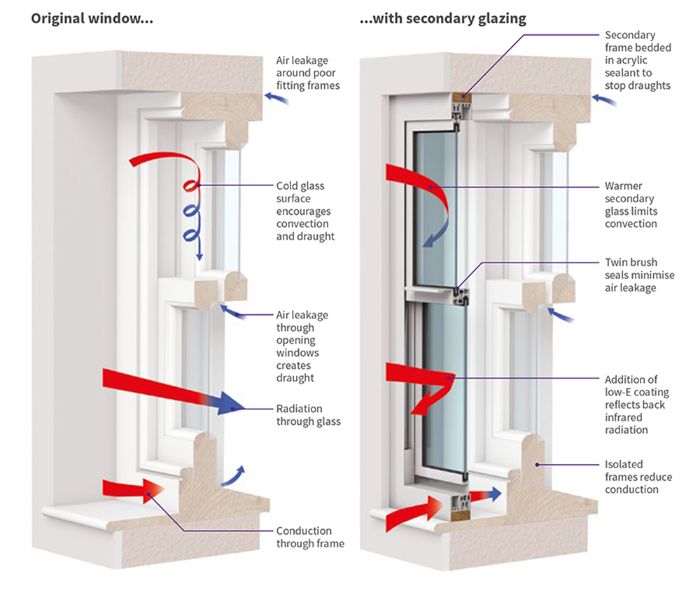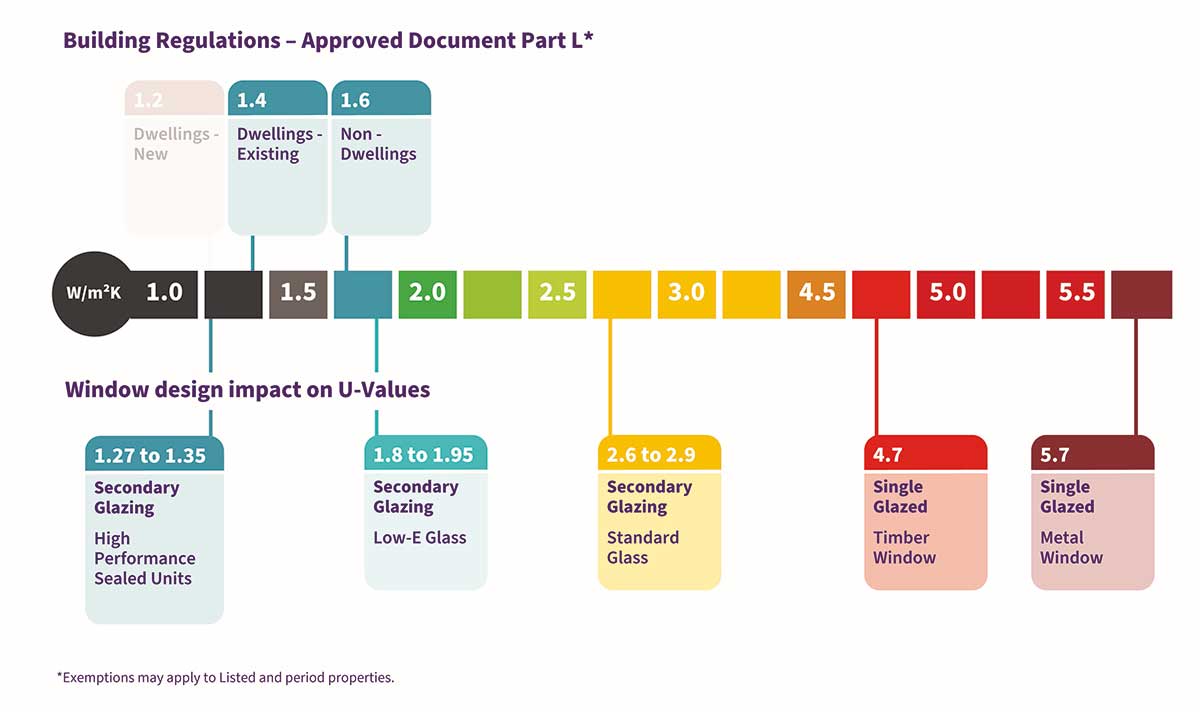The secondary window traps an insulating mass of air between the inner and outer glass which reduces heat loss, increases U-values, and if a low-E glass is used it will reflect back infrared radiation and so retain even more heat in the room. The isolated frames are also less conductive. The resulting warmer surface of the inner glass limits uncomfortable convection currents. Draughts are significantly reduced by efficient seals applied both to the outer frame and opening panels and these can also improve air quality by limiting the amount of dust and dirt that can pass through.
Key Benefits
- Minimised draughts
- Improved room comfort
- Reduced energy bills
- Increased EPC rating
- Increased BREEAM rating

Regulations and standards
- Building Regulations Approved Document L: Parts L1B and L2B:
These cover the energy efficiency in residential and commercial buildings undergoing renovation or upgrades. Controlled fittings such as windows must meet strict performance standards (see performance table). The regulations acknowledge the sensitivity of working in Listed buildings and single glazed windows that are part of the historic fabric of the building can be retained and secondary glazing fitted with Low-e glass, subject to Listed Building Consent. - BREEAM:
This is the UK’s leading assessment method for sustainability in buildings and addresses many issues including energy, health, and wellbeing. Secondary glazing can effectively contribute towards a higher rating. - Energy Performance Certificate (EPC) and Minimum Energy Efficiency Standards (MEES):
Energy performance certificates show the energy efficiency of a building with an A rating being very efficient and a G rating inefficient. An EPC is needed when buying or renting a property and the MEES regulations which came into effect 1st April 2018 require residential and commercial property to have an EPC rating of ‘E’ or above if a new lease is to be created or a lease renewed. Retrofitted secondary glazing can be a fast and effective way to improve an EPC rating making it more attractive to a tenant. - PassivHaus/EnerpHit:
New homes with Passivhaus certification are designed to maximise the comfort of occupants whilst using minimal energy for heating and cooling. An existing building can also be retrofitted to be a very low energy home and certified to the Passivhaus/Enerphit standard. This is slightly lower than full Passivhaus in recognition of the difficulties with existing building designs or conservation needs. Besides significant insulation, a high degree of air tightness is required together with a mechanical ventilation system using heat recovery. Secondary glazing can be an important contributor to Enerphit certification. - WELL (Well Building Standard):
A performance-based standard for creating and certifying spaces that put health and well-being of the users at the forefront of the building design or retrofit. Considering thermal comfort and acoustic designs are just two of the areas that need to be considered for certification and secondary glazing can provide beneficial solutions.
Secondary glazing U-value performance comparisons

Guidance
- U-value:
A measurement of heat loss expressed in W/m2K and shows the rate of heat loss per square metre of material, the lower the figure the better the insulation. - Low-E glass:
This has a hard metallic coating on the surface facing the cavity that significantly helps with heat containment. - g-value:
This is the solar factor of a window expressed as a number between 1 and 0, where 1 indicates the maximum solar gain and 0 equals no solar gain. The warming effect of high g-value can be a benefit in winter but a problem in summer months. A standard single glass generally achieves 0.8 and this is reduced in combination with different glass types but if solar gain is a significant problem, for example on a south facing façade, a specialist window film can be applied to the primary window.
U-value performance of Selectaglaze secondary glazing
The thermal performance of the product range has been assessed against both timber and metal primary windows by the Centre for Windows and Cladding Technology (CWCT). The window size is 1480m(w) x 1230mm(h) and all figures are in W/m²K| Timber primary + secondary unit 100mm cavity | Metal primary + secondary unit 100mm cavity | |||||||
| Product | 6mm clear float | 6mm low-E | 4-12-4 SU low-E and gas | 24mm Enhanced Thermal Sealed Unit | 6mm clear float | 6mm low-E | 4-12-4 SU low-E and gas | 24mm Enhanced Thermal Sealed Unit |
| S10 HS | 2.629 | 1.807 | - | - | 2.911 | 1.936 | - | - |
| S80 HS | 2.640 | 1.810 | - | - | 2.920 | 1.940 | - | - |
| S85 HS | 2.700 | 1.840 | - | - | 3.000 | 1.970 | - | - |
| S20 VS | 2.617 | 1.802 | - | - | 2.897 | 1.930 | - | - |
| S60 VS | 2.639 | 1.812 | - | - | 2.924 | 1.942 | - | - |
| S90 VS | 2.615 | 1.801 | - | - | 2.894 | 1.929 | - | - |
| S95 VS | 2.698 | 1.840 | - | - | 2.996 | 1.974 | - | - |
| S41 HC | 2.581 | 1.785 | 1.627 | 1.27 | 2.852 | 1.910 | 1.731 | 1.34 |
| S45 HC | 2.576 | 1.782 | - | - | 2.846 | 1.908 | - | - |
| S50 HC | 2.589 | 1.788 | 1.700 | 1.32 | 2.862 | 1.915 | 1.813 | 1.38 |
| S31 LO | 2.585 | 1.787 | - | - | 2.858 | 1.913 | - | - |
| S41 LO | 2.581 | 1.785 | 1.627 | 1.27 | 2.852 | 1.910 | 1.731 | 1.34 |
| S45 LO | 2.576 | 1.782 | - | - | 2.846 | 1.908 | - | - |
| S40 FL | 2.574 | 1.781 | 1.435 | 1.15 | 2.843 | 1.906 | 1.515 | 1.21 |
| S46 FL | 2.579 | 1.784 | - | - | 2.850 | 1.910 | - | - |
| S55 DFL | 2.612 | 1.800 | - | - | 2.891 | 1.927 | - | - |